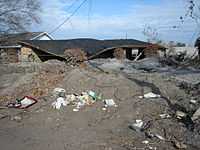7th Ward of New Orleans

The 7th Ward is a section of New Orleans, Louisiana. It is geographically the second largest of the 17 Wards of New Orleans, after the 9th Ward.[1]
Boundaries and geography
The 7th Ward stretches from the Mississippi River to Lake Pontchartrain. The eastern, or "lower" boundary is Elysian Fields Avenue, the boundary with the 8th Ward. In the "up-river" direction to the south-west, the boundary is Esplanade Avenue, the border with the 6th Ward; then from where Esplanade meets Bayou St. John the boundary follows the bayou north to the lake, with the 5th Ward being across the bayou.
Features and landmarks
The London Avenue Canal runs through the ward from just in from Gentilly Ridge to the Lake. Dillard University is in the Ward, as is most of the University of New Orleans campus near the lakefront. The New Orleans Fairgrounds, home to horse racing and the New Orleans Jazz & Heritage Festival, is just back from Esplanade Avenue, as is Saint Louis Cemetery #3. Frenchmen Street, the popular destination for food and live music, is in the front of the ward near the French Quarter.
History
As with most of New Orleans, the area along the high ground of the riverfront was developed first; this area is today the Marigny Triangle of the Faubourg Marigny. The Pontchartrain Railroad, the first US railroad away from the Atlantic coast, ran for a century along Elysian Fields between the Riverfront and the famous camps at Milneburg. The area is known for the Creole citizens who once heavily populated the area. Esplanade Ridge between Rampart and Bayou St. John was one of the first parts of town substantially developed away from the riverfront. Some of the elegant early 19th century Creole-style mansions can still be seen along Esplanade. The areas between Gentilly Ridge and the Lakefront was developed in the 20th century with improved drainage; see Drainage in New Orleans.

When Hurricane Katrina struck New Orleans in 2005, the effects were disastrous. The London Avenue Canal breached catastrophically on both sides, flooding the majority of the Ward and the surrounding area. The 7th ward has since seen many residents return.
Famous 7th Ward New Orleanians
Notable people from the 7th Ward include jazz musicians/composers Lionel Ferbos, Jelly Roll Morton, Barney Bigard, and Sidney Bechet, singer Lee Dorsey, musician/composer [(Darryl "Lil Jazz" Adams, Tornado Brass Band)}, singer Lizzie Miles, rapper/producer Mannie Fresh, rapper Mia X, rapper MC L, author/commentator Melissa Harris-Perry, civil rights leader A. P. Tureaud, playwright Tyler Perry, author Fatima Shaik, award-winning author & Folklorist Dr. Mona Lisa Saloy, singer-songwriter Frank Ocean, Tyrann Mathieu football player for the LSU Tigers, and mayors Ernest Morial, Sidney Barthelemy and C. Ray Nagin. Joseph "Joe" Dorsey, Jr. sued the state of Louisiana for the right to fight against white opponents. July 28, 1955, Dorsey, with the help of Berry and Augustine, sued the Louisiana State Athletic Commission. In November 1958, a three-judge federal court in New Orleans found both the Louisiana law and the athletic commission's own rule against interracial bouts unconstitutional. Writing the opinion, one of his earliest on a civil-rights matter, Judge John Minor Wisdom of the United States Court of Appeals for the Fifth Circuit held that the Louisiana law was "unconstitutional on its face in that separation of Negroes and whites based solely on their being Negroes and whites is a violation of the Equal Protection Clause of the Fourteenth Amendment of the Constitution of the United States," and that segregated boxing matches were no exception. Louisiana appealed the ruling, which was upheld by the Supreme Court in May 1959. The decision officially ended segregated athletic competition in the state, although it did not extend to the seating at sporting events, which remained segregated.
References
- ↑ New Orleans Districts and Wards
| Wikimedia Commons has media related to 7th Ward of New Orleans. |
| ||||||||||||||||